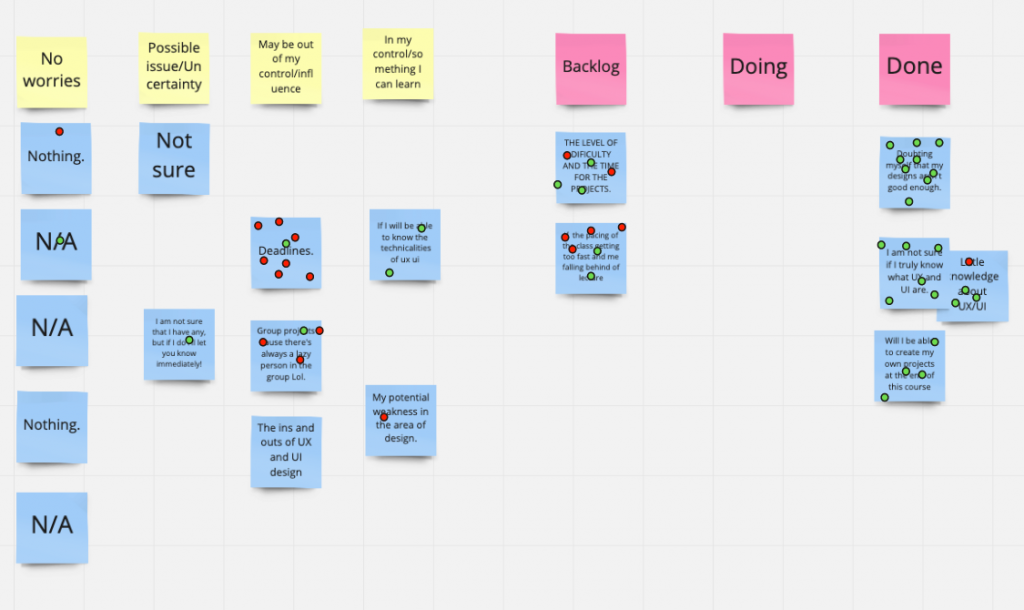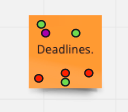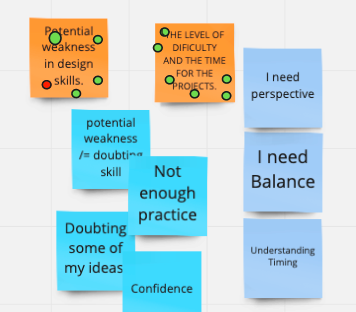My friend Austin Govella wrote today on using a kind of whole-body dot voting to teach teams to “Vote With Your Feet“. We are in a Liminal Thinking group on Facebook where he initially threw his ideas around. I was excited that he chose to add my comment about using negative dots to vote down ideas, and use them in my undergraduate UX class as a discussion point about what we Won’t do or talk about on a project.
My students get to use dot voting on the first day of our UX/UI class at CUNY CityTech, where we talk about what we are worried about for the upcoming semester. Addressing concerns and potential problems is a good exercise in most occasions, but in these days of online classes, crushing economy and pandemic, talking about our worries is particularly important. It helps to alleviate anxiety and develop a growth mindset toward the months ahead.

In this first class, the students learn about a number of design practices using a shared, online whiteboard, including brainstorming, dot voting, cluster analysis, and Kanban as part of a pre-mortem exercise on what can go wrong with the class. (I learned this exercise while teaching with Jimmy Chandler at the New York Code and Design Academy and modified it for online classes).
To begin, students use virtual sticky notes to write down their concerns about the coming semester. Then the students attach green and red mini circles, three each, to vote on which issues they want to discuss and which ones they don’t. Then we use Kanban (To do, Doing, Done) to keep the discussion orderly.
When I used the technique earlier on, I allowed each student three dots to vote on ideas that they want to discuss. There are usually concerns expressed that are common students commuting to our downtown Brooklyn campus, like getting to class on time (what if the subway breaks down? what if my work goes overtime?), having too much homework (it is a lot of homework, tbh), or dealing with a teammate that doesn’t pull their share (this happens on the job, too, unfortunately). It was OK. But these concerns, being fairly common are covered in the syllabus in the items about time management, group behavior and attendance, so the discussion becomes somewhat procedural.
There are of course new and now-common issues this semester about logging into school instead of commuting, managing family and job expectations, particularly for those students whose families rely on their job income and dealing with the combined stress of school, real and potential loss of family members (at least two of my students had a COVID death in the family and many have been displaced or ill), and just living in the 2020 political and budgetary climate. These issues are very personal and went largely unspoken but manifested as concerns about deadlines, time management and doubts that they have the skills it takes to be successful.

By allowing the students to select some issues that are not particularly a concern was a new idea and I found it especially interesting to explore them with the class. So along with items that have a lot of upvotes, I also selected items that have some upvotes, but also a few downvotes (more than one downvote, so as not to put any one person on the spot).
“Not a Concern” is key phrasing. For the upvote dots, I told the students to “mark items they want to talk about.” For downvote dots, the instructions are “mark items that are Not a Concern.” Te fact that someone wrote the issue on a sticky note in the first place means it is a concern for some students. I inferred from the “Not a Concern” votes that maybe there are people who have discovered ways to deal with the problem.

And for a teacher, it highlights differences in each class (there are always differences) that point to certain pedagogical approaches. For instance in one section the most up-voted concern was “potential weakness in design skills.” In the other section, a similar issue got a lot of down-votes. I wanted to know what was going on so made sure to expand on that concern in the second week’s discussion and begin a discussion of skills development, the importance of practice, and imposter syndrome.
This then becomes an opportunity for a discussion of growth. I tell them to ask themselves, How can I, as a student in a rigorous BFA program, discover ways to develop perspective so I understand where the doubt is coming from? How can I build confidence? Through practice, time management and simply being honest about the particularly stressful challenges this world is throwing at us and asking for help.
So cheers to Austin for giving me a fun topic to explore here. While you are at it, you can find his book, Collaborative Product Design at https://www.agux.co/cpd.
